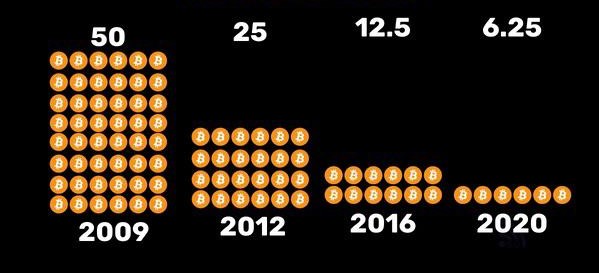Next Halving Countdown
Block Height
Loading...Blocks Until Halving
Calculating...Price Change since Halving
Loading...Initially, when Bitcoin was created, its code was designed so that the mining of each block would occur approximately every 10 minutes. This rate was chosen to balance network security and transaction efficiency. At the launch of Bitcoin in 2009, the reward for miners to add a new block to the blockchain was 50 Bitcoins.
To ensure a gradual and limited supply of Bitcoins, the Bitcoin code introduced the concept of “halving”, which means periodically reducing miner rewards. This occurs every 210,000 mined blocks, about every 4 years. In 2012, the first halving took place, cutting miner rewards from 50 Bitcoins to 25 Bitcoins per mined block.
This process was repeated twice more, in 2016 and 2020, leading to the reward being reduced to 12.5 Bitcoins and then to 6.25 Bitcoins per mined block. This halving strategy was designed to gradually decrease the rate of new Bitcoin creation, contributing to planned scarcity and theoretically increasing the perceived value of the currency over time.

The reduced supply entering the market can lead to a supply shock weeks after the halving event:
| Cycles | Date | Price at Halving | ATH Price | End Price |
|---|---|---|---|---|
| 1st Halving | 28.11.12 | $ 12.30 |
$ 1,163(+9,355%)
|
$ 650.00(+5,184%)
|
| 2nd Halving | 9.07.16 | $ 650.00 |
$ 19,650(+2,923%)
|
$ 8,590(+1,221%)
|
| 3rd Halving | 11.05.20 | $ 8,590 |
$ 73,682(+758%)
|
$ 63,876(+643%)
|
| 4th Halving | 20.04.24 | $ 63,876 |
N/A
|
N/A
|
Frequently Asked Questions About Bitcoin Halving:
Additionally, Bitcoin halving dates are coded into the system and will persist until miners’ block rewards reach zero, precisely 0.00000000 BTC. This milestone is anticipated to occur in the year 2140.
This systematic reduction in Bitcoin mining rewards, provided to miners for successfully validating and adding new blocks to the Bitcoin blockchain, carries significant implications for the entire Bitcoin ecosystem.
During a Bitcoin Halving event, the block reward is halved, resulting in miners receiving 50% fewer new Bitcoins for their mining efforts. In Bitcoin’s early days, the block reward began at 50 Bitcoins. After the first Halving in 2012, it reduced to 25 Bitcoins. The most recent Halving occurred in 2020, lowering the reward to 6.25 Bitcoins per block. The upcoming Halving, scheduled for 2024, will further reduce the block reward to 3.125 BTC.
The Bitcoin Halving serves the purpose of controlling Bitcoin’s inflation rate. By decreasing the rate at which new Bitcoins are generated, it aims to cap the total supply at 21 million, transforming Bitcoin into a deflationary digital asset over time. Historically, this event has significantly influenced the Bitcoin market, often triggering heightened demand and, consequently, potential price appreciation.
Investors, miners, and the broader crypto community closely track Halving events due to their potential impact on Bitcoin prices and the overall crypto market. Traders and enthusiasts view this event as a pivotal factor in shaping their investment strategies and market predictions.
The Bitcoin halving date is expected to occur within a few days of the predicted date. However, if the Bitcoin hashrate experiences a substantial increase, the halving date may occur sooner.
